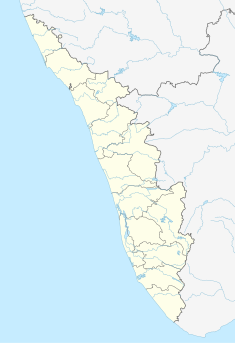| This article needs additional citations for verification. Please help improve this article by adding citations to reliable sources. Unsourced material may be challenged and removed. Find sources: "Fort Emmanuel" – news · newspapers · books · scholar · JSTOR (April 2023) (Learn how and when to remove this message) |
Historic site in Kochi, India
| Fort Emmanuel | |
|---|---|
| Native name ഫോർട്ട് കൊച്ചി (Malayalam) | |
 Watercolour painting of the fort of Cochin, with a British flag, from across the backwaters, unknown artists, around 1800 AD. Watercolour painting of the fort of Cochin, with a British flag, from across the backwaters, unknown artists, around 1800 AD. | |
| Location | Fort Kochi, Kochi, India |
| Coordinates | 9°57′59″N 76°14′21″E / 9.9663°N 76.2391°E / 9.9663; 76.2391 |
| Built | 1503; 522 years ago (1503) |
| Architectural style(s) | Portuguese |
 | |
Fort Emmanuel, also known as Fort Manuel, is a ruined fort located at Fort Kochi Beach in Kochi, Kerala, India. It was a bastion of the Portuguese and a symbol of the strategic alliance between the Maharaja of Kochi and the Kingdom of Portugal. Named after Manuel I of Portugal, it was the first Portuguese fort in Asia.
History
In September 1503, the King of Kochi granted permission to Afonso de Albuquerque to build Fort Emmanuel near the waterfront of the Arabian Sea. The construction was commenced on 26 September, and "it took the shape of a square with flanking bastions at the corners mounted with ordnance". The walls were made of double rows of coconut tree stems securely fastened together and with earth rammed firmly between; it was further protected by a wet ditch. The fort was christened on the morning of 1 October 1503 "Emmanuel", after the King of Portugal.
The fort was built at the water-bound region towards the south-west of the Kochi mainland. The fortifications were reinforced in 1538. The Portuguese built their settlement behind the fort, including the St Francis Church. Fort Kochi remained in Portuguese possession until 1663, when the Dutch captured the territory and destroyed the Portuguese institutions. The Dutch held the fort in their possession until 1795, when the British took control by defeating the Dutch. By 1806 the Dutch, and later the British, had destroyed most of the fort walls and its bastions.
In Old Kochi and alongside the Fort Kochi beach, there is a partially restored gun battery and other remains of ramparts and fortifications, which are now tourist destinations.
Gallery
-
cannon bastion located at the Fort Kochi Beach
-

-

References
- ^ "Fort Immanuel at Fort Kochi". keralatourism.org. Retrieved 22 October 2014.
- "Fort Immanuel at Fort Kochi | Ernkulam Destinations". Kerala Tourism. Retrieved 19 August 2020.
- ^ Logan, William. Malabar. District Manual. Asian Educational Services, 1887.
External links
![]() Media related to Fort Emmanuel, Kochi, Kerala at Wikimedia Commons
Media related to Fort Emmanuel, Kochi, Kerala at Wikimedia Commons
| Kochi | |
|---|---|
| Landmarks | |
| Neighbourhoods | |
| History | |
| Transport |
|
| Government | |
| Organizations | |
| Malls | |
| Culture | |
| Places of worship |
|
| Health care |
|
| Schools |
|
| Universities |
|
| Roads | |
| Sports | |
| Press | |
| Television channels | |
| Tourism in Kerala | |
|---|---|
| Organisations | |
| Informative articles | |
| Airports | |
| Amusement parks | |
| Archaeological sites | |
| Beaches |
|
| Boat races | |
| Caves | |
| Dams |
|
| Festivals |
|
| Forts | |
| Islands | |
| Lakes | |
| Lighthouses | |
| Mountains |
|
| Museums |
|
| Palaces |
|
| Ancient residences | |
| Waterfalls |
|
| Wildlife sanctuaries |
|
| Zoos | |
- 1500s establishments in Portuguese India
- 1503 establishments in India
- Archaeological sites in Kerala
- Buildings and structures in Kochi
- Colonial Kerala
- Forts in Kerala
- History of Kochi
- Buildings and structures completed in 1503
- Kingdom of Cochin
- Portuguese forts in India
- Portuguese in Kerala
- Tourist attractions in Kochi